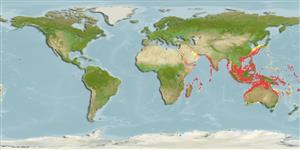Common names from other countries
Environment: milieu / climate zone / depth range / distribution range
Ökologie
seewasser riff-verbunden; standorttreu; tiefenbereich 10 - 300 m (Ref. 9790). Tropical
Indo-West Pacific: widespread, from the New Hebrides to Papua New Guinea, north to Taiwan, through Indonesia to Thailand, Pakistan, the Red Sea, and South Africa. Replaced by Cociella crocodilus from southern China to Japan and by Cociella hutchinsi in northern Australia (Ref. 37816).
Size / Gewicht / Alter
Maturity: Lm ? range ? - ? cm
Max length : 35.0 cm TL Männchen/unbestimmt; (Ref. 9790); common length : 25.0 cm TL Männchen/unbestimmt; (Ref. 9790)
Rückenflossenstacheln (insgesamt) : 9; Rückenflossenweichstrahlen (insgesamt) : 10 - 12; Afterflossenstacheln: 0; Afterflossenweichstrahlen: 11 - 12. Uppermost preopercular spine reaching only about half-way to the opercular margin. Preorbital spine present. Infraorbital ridge usually smooth over anterior 1/2 of eye. Suborbital ridge lacking spines behind eye. Interopercular flap present. Iris lappet simple, semicircular. Numerous small dark spots on back reaching to below the lateral line, more widely scattered posteriorly. Has 5-6 dark bands across the back, but small juveniles may have only a broad saddle crossing the spinous dorsal fin and a narrow one near the rear of the soft dorsal fin (Ref. 37816).
Frequents shallow areas in depths of 10 m or less. Taken in trawl fisheries at depths from 23 to 250 m. Reported from a trap in the Gulf of Aqaba at a depth of 300 m. Young to juvenile stages utilize mangrove habitat (Ref. 9790). Adults occur in silty sand habitats from the shallows to a depth of 300 m (Ref. 37816). Also found in coastal sand patches, near coral reefs but more often on offshore (Ref 90102).
Life cycle and mating behavior
Maturities | Fortpflanzung | Spawnings | Egg(s) | Fecundities | Larven
Knapp, L.W., 1999. Platycephalidae. Flatheads. p. 2385-2421. In K.E. Carpenter and V.H. Niem (eds.) FAO species identification guide for fishery purposes. The living marine resources of the Western Central Pacific. Volume 4. Bony fishes part 2 (Mugilidae to Carangidae). FAO, Rome. (Ref. 9790)
IUCN Rote Liste Status (Ref. 130435)
CITES (Ref. 128078)
Not Evaluated
Bedrohung für Menschen
Harmless
Nutzung durch Menschen
Fischereien: weniger kommerziell
Tools
Zusatzinformationen
Download XML
Internet Quellen
Estimates based on models
Preferred temperature (Ref.
115969): 18.8 - 28.1, mean 25.6 (based on 1088 cells).
Phylogenetic diversity index (Ref.
82804): PD
50 = 0.5312 [Uniqueness, from 0.5 = low to 2.0 = high].
Bayesian length-weight: a=0.00525 (0.00246 - 0.01120), b=3.04 (2.85 - 3.23), in cm Total Length, based on LWR estimates for this (Sub)family-body shape (Ref.
93245).
Trophic level (Ref.
69278): 3.8 ±0.7 se; based on size and trophs of closest relatives
Widerstandsfähigkeit (Ref.
120179): mittel, Verdopplung der Population dauert 1,4 - 4,4 Jahre. (Preliminary K or Fecundity.).
Fishing Vulnerability (Ref.
59153): Low vulnerability (25 of 100).
